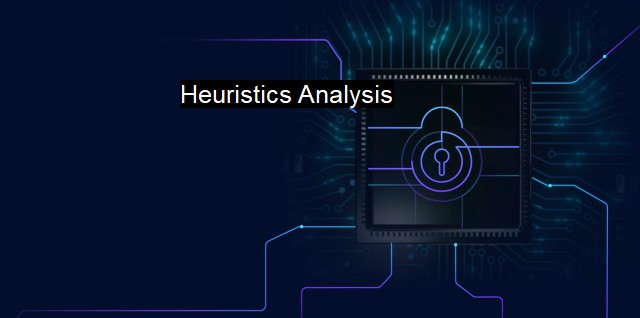What are Heuristics Analysis?
Enhancing Cybersecurity Measures: An Introduction to Heuristic Analysis - Proactive Approach in Detecting Unknown Threats
Heuristic Analysis in the context of cybersecurity and antivirus refers to a technique used by many commercial and corporate antivirus solutions to identify malicious activities or behaviors that could potentially harm an electronic system or network. It is essentially an algorithm employed to analyze software and determine if it behaves like malware.This special algorithm uses specific methodologies to identify new malware or virus threats that haven't yet been officially discovered or catalogued. Analogous to the mental strategy human beings adopt in problem-solving known as "heuristics," Heuristic Analysis in cybersecurity is similar in that it employs a practical, intelligence-driven approach instead of a step-by-step deterministic process while detecting malware. Very often, heuristic methods are able to efficiently produce results good enough only when the typical optimal algorithm is too slow or complicated to implement.
Heuristic Analysis looks for suspicious behavior, contents and structures of a file, and primarily focuses on the analysis of code. It examines the whole file or pieces of it that have high potential to be harmful, these areas are often termed heuristic "signatures". Therefore, if a piece of code attempted to register itself to autoplay, then it would probably light up as a heuristic signature, possibly indicating the presence of a worm.
This technique contains different types—anomaly detection looks for behavior that deviates from normal or acceptable behavior. In binaries and scripts, system call analysis acts an oracle seeing how a software interacts with the operating system, detecting potential threats. And in contrast to signature-based detection which uses existing virus definitions to check for known viruses, heuristic analysis scrutinizes both known and unknown viruses and even mutated ones to prevent zero-day attacks.
One of the most powerful features of this type of analysis is being proactive rather than. Heuristic Analysis can offer pre-emptive protection against malware that are yet to be discovered. Unlike traditional antivirus software that guards against known threats, heuristic analysis "estimates" and acts ahead of time.
Like most software solutions, heuristic analysis is not without disadvantages. There is always a likelihood of false positives, genuine software flagged as potential malware, resulting from the estimations the heuristic analysis broadly utilizes. This can bring complications especially when vital system files become affected.
Heuristic analysis could slow down system operation as it uses more of the computer's processing power. It scrutinizes every piece of software, and as such, opening and using files can become slower. heuristic analysis is not hundred percent reliable since proactive virus detection can never be completely accurate. Cybercriminals and hackers continuously evolve and find innovative ways to thwart the system and disrupt order.
Despite these drawbacks, the benefits that heuristic analysis brings in relation to cybersecurity outweigh its disadvantages. In the ever-evolving world of malware and cybersecurity threats, software must adapt quickly and proactively. Antivirus backed with heuristic analysis is one piece in that giant puzzle.
Heuristic analysis, especially when paired with other antivirus technologies, represents an essential line of defense against arising threats in the cybersecurity domain. Given the lucidity and urgency in combating emerging cyber threats, it's clear that heuristic techniques offer a remarkably proactive, and often necessary, approach to maintain the integrity and security of digital systems in our increasingly digital-dependent age. Its integration with other antivirus mechanisms has ultimately revolutionized the way cybersecurity is managed, promoting an omnipresent shield for digital infrastructures worldwide.

Heuristics Analysis FAQs
What is heuristics analysis in the context of cybersecurity and antivirus?
Heuristics analysis is a technique used in cybersecurity and antivirus software to identify and analyze potential threats by examining their behavioral patterns. It involves examining patterns and characteristics of a file or program to determine whether it is malicious or not, without relying on known signatures of known viruses.How does heuristics analysis help in detecting new and unknown threats in cybersecurity?
Heuristics analysis is particularly useful in detecting new and unknown threats in cybersecurity because it looks for behavior that deviates from normal patterns. By analyzing the behavior of files or programs, heuristics engines can detect suspicious activities that indicate the presence of malware, even if it hasn't been previously identified or classified.What are the limitations of heuristics analysis in cybersecurity and antivirus?
Heuristics analysis can sometimes produce false positives, which can be frustrating for users and can put unnecessary strain on system resources. Additionally, sophisticated malware can be designed to evade heuristics detection by mimicking normal activity, making it difficult for heuristics engines to identify them.How can heuristics analysis be improved to enhance the effectiveness of cybersecurity and antivirus programs?
Heuristics analysis can be improved by combining it with machine learning techniques, which can help to reduce false positives and improve malware detection rates. Additionally, heuristics engines can be trained to recognize new and emerging threats by analyzing patterns of behavior across multiple instances of malware, further enhancing their ability to detect and respond to new threats.| | A | | | B | | | C | | | D | | | E | | | F | | | G | | | H | | | I | | | J | | | K | | | L | | | M | |
| | N | | | O | | | P | | | Q | | | R | | | S | | | T | | | U | | | V | | | W | | | X | | | Y | | | Z | |
| | 1 | | | 2 | | | 3 | | | 4 | | | 7 | | | 8 | | |||||||